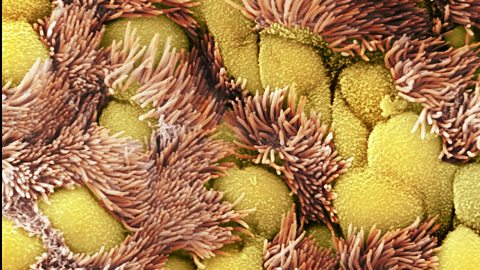Defence against infection
The body is constantly defending against attacks from pathogenMicroorganism that causes disease.. The first line of defence against infection stops the pathogens from entering your body. These first lines are general defences, and are not specific to fight against certain types of pathogen. We call this non-specific, and they can be physical or chemical barriers.
Physical barriers against infection
Skin
The skin covers almost all parts of your body to prevent infection from pathogens. If it is cut or grazed it immediately begins to heal itself, often by forming a scab, which prevents infection as the skin acts as a physical barrier. Parts of the body that do not have skin have developed other ways to prevent infection. For example, the eyes produce tears which contain enzymeA protein which catalyses or speeds up a chemical reaction.. These enzymes are chemical barriers.
Nose
The nose has internal hairs, which act as a physical barrier to infection. Cells in the nose produce mucusSlimy white protein, which lines the respiratory tract and alimentary canal.. This traps pathogens before they can enter the lungs. When the nose is blown, mucus is removed and any pathogens are trapped within it.
Mucus and ciliated cells
The tracheaThe windpipe, the tube that leads from the mouth towards the lungs. runs from the nose towards the lungs. The cells that line the trachea also have hairs called ciliaTiny hair-like projections from a cell that usually allow it to move a substance past the cell (for example, in the bronchioles in the lungs)., which are much smaller than those in the nose. These are called ciliatedCells with tiny hair-like structures on their surface are said to be ciliated.. The ciliated cells waft their hairs in a motion like a Mexican wave at a football match and move mucus and pathogens upwards towards the throat where it is swallowed into your stomachMuscular organ in the digestive system that produces hydrochloric acid and protease enzymes.. Other cells called goblet cellsCells in the lining of the airways that produce mucus to trap dust and pathogens. create the mucus in order to trap pathogens. The production of mucus in your airways is a physical barrier.

Chemical barriers against infection
Stomach acid
The hydrochloric acid in our stomachs does not break down food. It is part of the body's non-specific first line of defence. It is hydrochloric acid and while it does us no harm, it is strong enough to kill any pathogens that have been caught in mucus in the airways or consumed in food or water. Stomach acid is a chemical barrier against infection.
Lysozymes
To stop eye infections we have evolved chemicals within our tears called lysozymesEnzymes found in tears that destroy bacterial cells.. These are enzymes that destroy bacterial cells by breaking down their cell walls. Lysozymes are found in saliva, breast milk and mucus, as well as in tears. Lysozymes are chemicals so, like stomach acid, they are a form of chemical defence against infection.

ł¦´Ç˛ÔÂáłÜ˛Ôł¦łŮľ±±ąľ±łŮľ±˛őIrritation of the membrane that surrounds the eye. can occur if pathogens are not killed by lysozymes